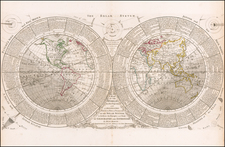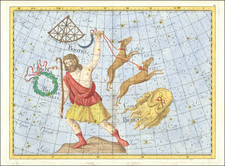A Stunning Depiction of a Comet. Made by the "Audubon of the Sky", Etienne Trouvelot.
This is a beautiful color lithograph showing a comet's trajectory made by Etienne Trouvelot, relating his observations made in the fall of 1874. The chromolithograph was published as part of Trouvelot's Astronomical Drawings set of 15 plates by Charles Scribner's Sons in 1882.
Trouvelot's drawings are known as some of the best images of the sky ever made. Trouvelot's work was very important at the time, as it provided important images of the stars, planets, and phenomena of the sky at a time when popular interest in astronomy was growing, but photography had not yet become advanced enough to capture such dark images. Trouvelot's images are recognized as the last of the great images of the night sky that surpassed the photography of their day. This comet was also the subject of the first successful photograph of a comet, which shows it as just a small ellipse of light. It would take decades for photography to surpass this depiction.
C/1881 K1, also known as the Great Comet of 1881
The comet of 1881 was first discovered by John Tebbutt, the Australian astronomer also credited with the discovery of the Great Comet of 1861, in May of that year. It would become visible in the northern hemisphere by mid-June, when Trouvelot made his drawing, and remain visible to the naked eye until September. The sheer brightness of the object earned it the title Great. It was a long period comet, with a time of revolution of at least two hundred years. A time of orbit of four hundred years has been suggested, giving a return at some point in the 23rd century.
Trouvelot's depiction of the comet is fantastic. The dust trail of the comet lights up the night sky and draws the viewer to the bright speck of light representing the comet itself. Trouvelot chooses an attractive scene for the foreground, showing the observatory he presumably worked at alongside a forested scene.
Trouvelot describes the comet as follows in his Trouvelot Astronomical Drawings Manual:
A view of the comet 1881, drawn as if seen with the naked eye, the minute details, however, being reproduced as seen with the telescope. The star-like nucleus is attended by four conical wings which cause it to appear diamond-shaped. The coma appears double, the brilliant inner coma, immediately enveloping the nucleus, being surrounded by a fainter exterior coma, which has a noticeable depression corresponding to that of the inner edge of the principal coma. The tail is divided lengthwise by a dark rift and is brightest on its convex or forward side. An inner portion of the tail, brighter than the rest, is more strongly curved, as if by solar repulsion. Stars are seen through the brighter parts of the tail, as they may be seen even through the coma and nucleus, with little diminution of their light.
Rarity
Trouvelot's prints were originally intended for the astronomical and scientific community and most of the larger US observatories purchased copies of the portfolio. In 2002, B.G. Corbin undertook a census to determine the number of surviving copies of the complete set of 15 prints and was only able to confirm the existence of 4 complete sets.
Trouvelot (1827-1895) was born in Guyencourt, Aisne, France. During his early years he was apparently involved in politics and had Republican leanings. Following a coup d'état by Louis Napoleon in 1852, he fled or was exiled with his family to the United States, arriving in 1855. They settled in the town of Medford, Massachusetts, where he worked as an artist and nature illustrator. In both 1860 and '70 census, his occupation is listed as lithographer.
Trouvelot had an interest as an amateur entomologist. In the U.S., silk-producing moths were being killed off by various diseases. Trouvelot brought some Gypsy Moth egg masses from Europe in late 1866 and was raising gypsy moth larvae in the forest behind his house. Trouvelot apparently understood the danger posed by the Gypsy Moths and housed them under netting. Unfortunately, an egg mass went missing during a storm in 1869. He immediately realized the potential problem he had caused and notified some nearby entomologists, but nothing was done. This story has been called into question, based on earlier reports Trouvelot made that his netting had holes in it large enough for robins to fit through and eat his caterpillars.
Shortly following this incident, Trouvelot lost interest in entomology and turned to astronomy. In this field he could put his skills as an artist to good use by illustrating his observations. His interest in astronomy was apparently aroused in 1870 when he witnessed several auroras.
When Joseph Winlock, the director of Harvard College Observatory, saw the quality of his illustrations, he invited Trouvelot onto their staff in 1872. In 1875, he was invited to the U.S. Naval Observatory to use the 26-inch refractor for a year. During the course of his life he produced about 7,000 quality astronomical illustrations. 15 of his most superb pastel illustrations were published by Charles Scribner's Sons in 1881. He was particularly interested in the Sun, and discovered "veiled spots" in 1875. Besides his illustrations, he published about 50 scientific papers.
In 1878, Trouvelot and his son traveled to Creston, Wyoming Territory, to observe the total eclipse of the Sun on July 29.
By 1882, Trouvelot had returned to France and joined the Meudon Observatory. He worked there under Jules Janssen, a leading solar astronomer. However, Trouvelot resented the cloudy French sky, which impeded his observations. He traveled with Janssen to the Caroline Islands in the South Pacific to observe the total eclipse of 1883 and attempt to discover the phantom intra-Mercurial planet.
Trouvelot died at Meudon on April 22, 1895. At the time he was working on a monograph of Mars. His son, George, hoped to find a publisher for Etienne's drawings of Mars, but was unsuccessful. The whereabouts of almost all of the drawings left by Trouvelot to his family are currently unknown.









![[Saturnus, Mercurius, Mars, Jupiter, Venus] Cap III](https://storage.googleapis.com/raremaps/img/small/78076.jpg)
![[Lupus and Centarus]](https://storage.googleapis.com/raremaps/img/small/74171.jpg)

![[Terrestrial Globe Gore] and [Celestial Globe Gore]](https://storage.googleapis.com/raremaps/img/small/91969.jpg)

![Sphere Droite [and] Sphere Parallele](https://storage.googleapis.com/raremaps/img/small/18779.jpg)